Volume 07, No.1 Pages 23 - 27
2. その他のビームライン/OTHER BEAMLINES
A Status Report : Taiwan APCST Contract Beamline BL12XU
Asia and Pacific Council for Science and Technology
- Abstract
- The Taiwan APCST contract beamline BL12XU is part of the Taiwan x-ray facility at SPring-8, and is dedicated for inelastic x-ray scattering (IXS) with variable energy resolution from high (0.1−1 eV) to ultra-high (1−10 meV) resolution regimes. A secondary purpose is for high Q-resolution scattering and x-ray physics and optics. The Phase I construction of the beamline was completed in November 2001. The commissioning of the undulator and front-end components was carried out successfully in early December, together with the hutch radiation survey. The beamline has since been approved for commissioning. In the present article, we will briefly describe the scientific program, the key concepts and components of the beamline, the IXS spectrometer, and the initial commissioning of the beamline.
Introduction
The Taiwan x-ray facility at SPring-8, which includes beamline BL12B2 and BL12XU, is facilitated by an international collaboration agreement signed between the Asia and Pacific Council for Science and Technology (APCST) and the Japan Synchrotron Radiation Research Institute (JASRI) on December 18, 1998. The proposed construction period spreads over 5 years, and we are now in the third year. The BL12B2 beamline has already been completed and open to users since October 2001. For the BL12XU beamline, the construction is carried out in several phases. The Phase I construction includes mainly the main beamline. The standard SPring-8 in-vacuum undulator was installed into the storage ring in January 2000. The hutches and utilities were constructed together with those of the BL12B2 beamline. The front-end components were installed in August 2000 during the summer shutdown. Installation of the beamline optics and transport components for the main beamline began in April 2001, and was completed in November 2001. In early December, the commissioning of the undulator and front-end components was carried out successfully, together with the hutch radiation survey. The beamline has since been approved by SPring-8 for commissioning.
Beamline Design
This beamline is designed primarily for inelastic x-ray scattering (IXS) experiments to explore frontier research in strongly correlated systems. Three classes of IXS experiments are planned:
・High-resolution inelastic x-ray scattering : The focus is on the study of single-particle as well as collective electronic excitations in a variety of materials.
・High-resolution x-ray resonant Raman scattering : The emphasis is to explore the large resonant enhancement of the inelastic scattering cross sections to study high-Z materials where strong absorption still poses a major problem.
・Ultra-high-resolution inelastic x-ray scattering : The focus is on the study of lattice dynamics in biomaterials and very low energy electronic excitations in strongly correlated systems.
We further plan to extend both the high and ultra-high resolution IXS to studies of materials under high pressure, high magnetic fields, and extreme temperatures. The focus is on pressure-induced phase transitions of materials.
A secondary purpose is for high Q-resolution scattering, and x-ray physics and optics. For scattering the scientific program will be of general purposes, and will include crystallography, surface scattering, magnetic scattering, small angle scattering, and coherent scattering. For x-ray physics and optics, the projects planned are micro focussing optics, fast timing optics, and non-linear multi-photon x-ray effects.
For IXS experiments, every photon counts. It is therefore important that the design of the beamline maximizes the delivered flux at the sample with the desired energy bandwidth.
Fig.1 shows the layout of the beamline. The beamline is divided functionally into two parts. Part I consists of a single-bounce diamond monochromator (DM) located at 41 m from the source point and a side hutch, providing a monochromatic beam of ~1-eV width over an energy range of 8−32 keV for crystallography and high Q-resolution scattering experiments. This part of the beamline will be built later.

Fig.1 Layout of the BL12XU beamline
Part II is the main part of the beamline and is dedicated to inelastic x-ray scattering. It contains five major optical elements, which include a high heat-load double-crystal monochromator (DCM), a collimating mirror (CM)/CRL (compound refractive lens), a high-resolution monochromator (HRM), a phase retarding plate (PR), and a focussing mirror (FM)/CRL. The DCM Si(111) crystals are cryogenically cooled to accept the full power and the full natural divergence of the central cone radiation of the undulator. The collimating mirror collimates the monochromatic beam from the DCM to further improve the throughput and the energy resolution of the output beam from the HRM. The relative energy bandwidth (ΔE/E) of the HRM will be in the range of 10-5 to 10-7. This is accomplished by using a design that allows for easy exchange of the channel-cut crystal pairs from either a two-bounce to an in-line or nested four-bounce crystal monochromator. Fig.2 shows 3 of the possible configurations of the HRM with the rest of the beamline optics. For a stable output beam with 10 meV resolution and higher acceptance, the HRM crystals will be temperature controlled to within ± 0.01 K at room temperature. The phase retarding plate is used only to generate circularly polarised light for magnetic studies. Finally the focusing mirror focuses the beam onto the sample position of the spectrometer.
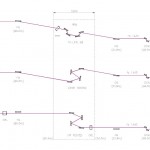
Fig.2 Three possible configurations of HRM and beamline optics for BL12XU
The main beamline will be optimised to operate in two regimes. The first regime uses primary beam energies in the range of 5−15 keV with an energy resolution in the order of 50−1000 meV, whereas the second regime employs 20−30 keV photons with an energy bandwidth in the order of 10−50 meV. The beamline layout remains practically the same with changes only to the choice of crystals for the HRM and the analyser. A few HRM options will be made available for different experiments. Furthermore, Be CRL’s will be used to replace the collimating and focussing mirrors for operations above 20 keV for their better performance at this energy range, particularly with energy resolution around 10 meV. Finally, the beamline design is also compatible with a backscattering monochromator for 1 meV resolution, operation.
A space is also reserved right after the HRM for a diffractometer, which provides the possibilities at the main beamline for high Q-resolution scattering experiments that require high brilliance light.
The IXS Spectrometer
The Phase I of the IXS spectrometer under construction is a triple-axis spectrometer with a 3 m horizontal arm. Fig.3 shows the overview of the design. It consists of a heavy-duty sample goniometer tower with flexible sample environment and a load capacity for a cryo magnet. A detachable cryostat carrier provides support for a cryostat with 0.5W cooling power at 4.2K. The 3-m horizontal arm provides support for the sample slit, the analyzer stage, the detector stage and the flight paths. Spherically bent crystal analyzers will be used to analyze the inelastically scattered photons. The analyzer stage can be translated continuously along the arm to accommodate three radii of the analyzer for different resolution requirements of the experiment. The motion mechanism of the detector stage will be designed to maintain both the sample and the detector on the Rowland circle of the analyzer.
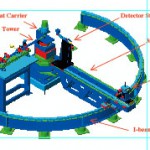
Fig.3 Overview of the Phase I inelastic x-ray spectrometer, designed in collaboration with the Advanced Design Consulting, Inc., NY, USA.
The spectrometer will be installed in early 2002. Our initial goal is to perform non-resonant inelastic x-ray scattering experiments with ~100 meV resolution at 10 keV. The scientific focus will be on the electronic excitations in a variety of materials of current interest.
As an indispensable part of the spectrometer, we have been investigating ways to build crystal analyzers with energy resolutions in the range of 50 - 100 meV. In order to release the strain induced by the spherical bending which broadens the energy bandwidth, the crystal can be diced into many small blocks either using a diamond saw or by the technique of reactive ion etching (RIE). One such analyzer with RIE-diced Si(111) wafer has been fabricated and is shown in Fig.4. Compared to dicing with a diamond saw, the RIE dicing is a non-strain process. It is possible to produce much smaller feature sizes, therefore maximizing the reflecting area for the x-rays. This type of analyzers is being characterized with x-rays. The results will be reported elsewhere.
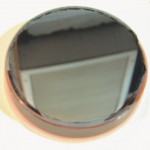
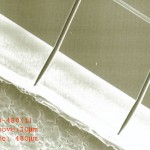
Fig.4 Spherically bent Si(hhh) analyzer with 2m bending radius on a glass blank. The 4-inch, 0.5-mm thick wafer was diced with the RIE technique with a groove size of about 20 µm, and a block size of about 480 µm. The diced depth was about 450 µm. The SEM image on a test wafer diced with the RIE technique using similar parameters is shown on the right.
Initial Commissioning
On December 5, according to schedule, we began the first day of commissioning. With the help of SPring-8 staff, we successfully commissioned the undulator and front-end components in the first day, and passed the radiation safety test of all hutches without major leakages in the following days. Fig.5 shows the group of people who participated in the hutch radiation survey. Thereafter we obtained permission from SPring-8 to operate the beamline without any restrictions.
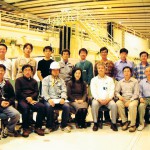
Fig.5 People from APCST, SPring-8, and the hutch manufacturer gathered together for a group photo after the hutch radiation safety test.
This marks the end of the Phase I construction period and also the beginning of a new phase of the beamline, in which we will actively pursue the scientific opportunities offered by this beamline using the experimental technique that this beamline has primarily been built for, namely inelastic x-ray scattering!
Commissioning of the beamline was already begun in the brief beam time before the winter shutdown right after we passed the radiation safety test, and will continue when SPring-8 returns to operation in the New Year. During the commissioning, we will perform detailed studies of beamline performance, including the DCM and mirrors alignment, energy calibration, and flux, energy resolution, and focussed beam size measurements, etc. IXS measurements on a few interesting systems are being prepared, and will be carried out after the spectrometer is installed and tested out.
Acknowledgement
We are grateful to many staff members of SPring-8 and APCST for their contributions to the Taiwan x-ray facility at SPring-8 in general and to the construction of the BL12XU beamline in particular. Special thanks are due to Dr. Tetsuya Ishikawa and Dr. Hideo Kitamura for their continuous support, and to former SPring-8 Director Dr. Hiromichi Kamitsubo for his leadership in promoting international collaboration. We also thank Dr. Chi-Chang Kao for his valuable advices on scientific issues relating to IXS. This project is under the directorship of Prof. C.T. Chen and Prof. K.S. Liang.
Yong Cai
Asia and Pacific Council for Science and Technology
Taiwan Beamline Office at SPring-8
TEL : 0791-58-1867 FAX : 0791-58-1868
e-mail : cai@spring8.or.jp
Cheng-Chi Chen
Asia and Pacific Council for Science and Technology
Taiwan Beamline Office at SPring-8
TEL : 0791-58-1867 FAX : 0791-58-1868
e-mail : ccchen@spring8.or.jp
Paul Chow
Asia and Pacific Council for Science and Technology
Taiwan Beamline Office at SPring-8
TEL : 0791-58-1867 FAX : 0791-58-1868
e-mail : pchow@spring8.or.jp
Ping-Chung Tseng
Asia and Pacific Council for Science and Technology
TEL : +886-3-578-0281 FAX : +886-3-578-3813
e-mail : tpc@srrc.gov.tw
Ching-Shiang Hwang
Asia and Pacific Council for Science and Technology
TEL : +886-3-578-0281 FAX : +886-3-578-3890
e-mail : cshwang@srrc.gov.tw
Gao-Yu Hsiung
Asia and Pacific Council for Science and Technology
TEL: +886-3-578-0281 FAX: +886-3-578-3890
e-mail: hsiung@srrc.gov.tw
Duan-Jen Wang
Asia and Pacific Council for Science and Technology
TEL : +886-3-578-0281 FAX : +886-3-578-3890
e-mai l: djwang@srrc.gov.tw
Bo-Yuan Shew
Asia and Pacific Council for Science and Technology
TEL : +886-3-578-0281 FAX : +886-3-578-3813
e-mail : yuan@srrc.gov.tw
King-Long Tsang
Asia and Pacific Council for Science and Technology
TEL : +886-3-578-0281 FAX : +886-3-578-3813
e-mail : king@srrc.gov.tw








